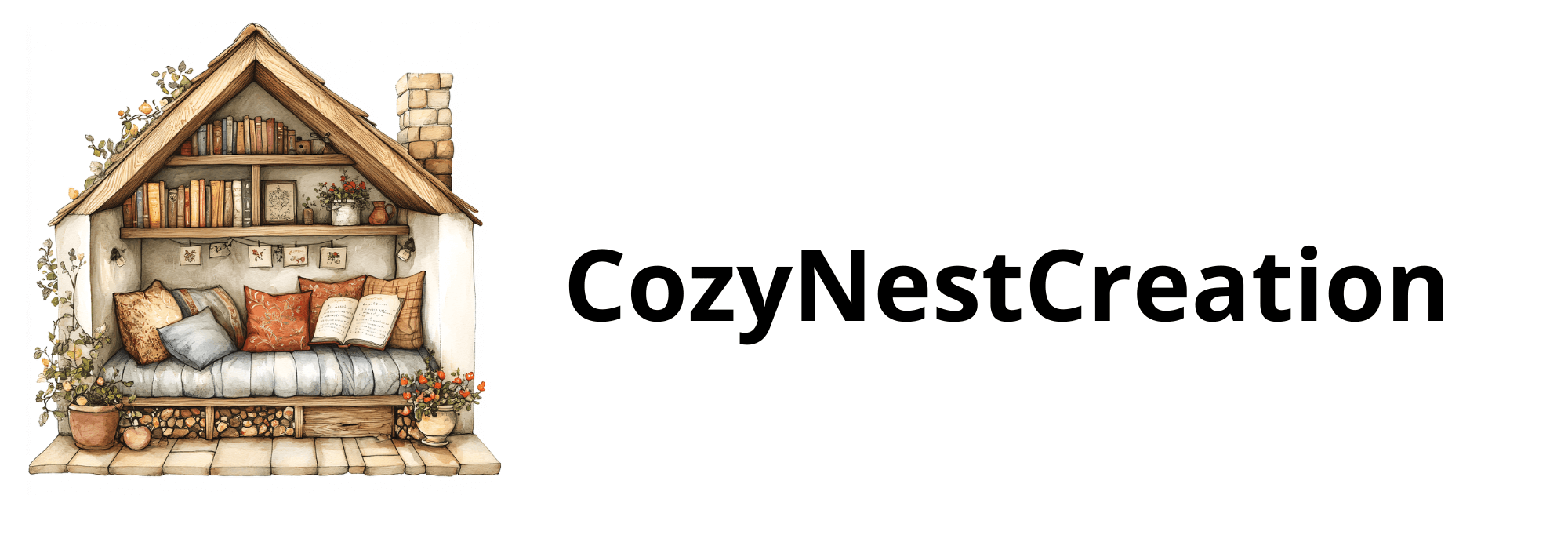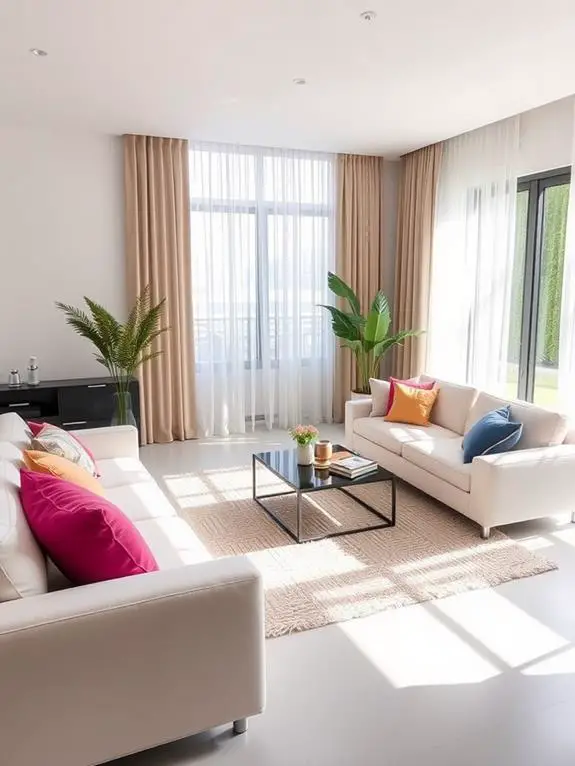You can transform your living space into a modern oasis without breaking the bank by strategically incorporating cost-effective textiles. Start by embracing natural fibers like cotton and linen, which offer durability and timeless appeal. Mix textures to add depth and visual interest, pairing smooth fabrics with rougher ones. Don't shy away from bold geometric prints or earthy tones to create a calming atmosphere. Layer different textiles, from plush rugs to soft throws, to enhance comfort and style. Consider DIY projects or repurposing old fabrics for unique decor pieces. With these tips, you'll be well on your way to elevating your interiors affordably and stylishly.
Key Takeaways
- Mix affordable natural fibers like cotton and linen with synthetic blends for durability and style.
- Layer textures by combining smooth fabrics with rough textures to add depth and visual interest.
- Incorporate bold geometric prints and earthy tones to enhance modern aesthetics on a budget.
- Repurpose existing textiles into unique decor pieces, such as turning curtains into throw pillows.
- Utilize end-of-season sales and fabric remnants to find high-quality textiles at lower prices.
Textile Trends in Modern Design
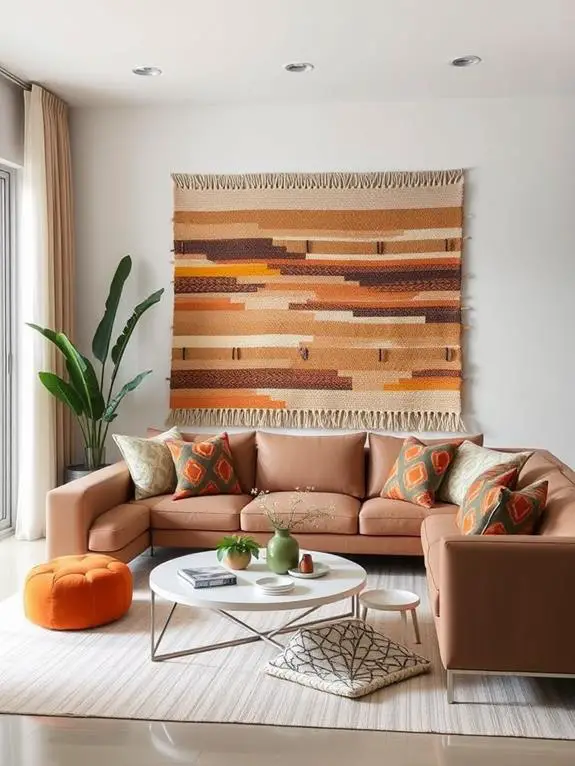
Modern textile design is experiencing a renaissance, blending innovation with sustainability. You'll find a delightful mix of textures and patterns that bring warmth and character to your living spaces. Natural fibers like organic cotton, linen, and hemp are taking center stage, offering both comfort and eco-friendly appeal. Bold, geometric prints are making a comeback, adding visual interest to sofas and accent chairs. For those looking to add a unique touch to their outdoor spaces, spring sculpture decor can provide an artistic element that complements your textile choices. Don't be afraid to mix and match; layering different textures creates depth and invites touch. Earthy tones and muted pastels are popular choices, creating a calming atmosphere that's perfect for unwinding after a long day. You'll also notice a trend towards multifunctional textiles, like throws that double as wall hangings or curtains that provide both privacy and sound absorption. Embrace these trends to transform your home into a cozy, stylish haven.
Budget-Friendly Fabric Selection Tips
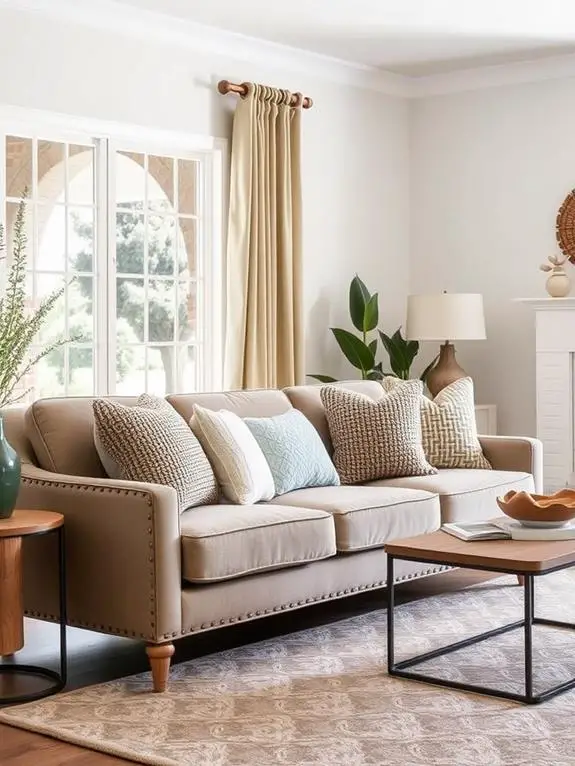
Selecting budget-friendly fabrics doesn't mean compromising on style or quality. You'll find that with a bit of creativity and know-how, you can transform your space using affordable textiles. Start by exploring natural fibers like cotton and linen, which offer durability and timeless appeal. Don't shy away from synthetic blends; they're often more cost-effective and can mimic the look of pricier materials. While site improvements are ongoing, you can still gather inspiration for your textile choices online. Keep an eye out for end-of-season sales or remnant pieces at your local fabric store. These hidden gems can yield stunning results without breaking the bank. Consider solid colors or simple patterns that'll stand the test of time, allowing you to mix and match with ease. Remember, texture is your friend – a chunky knit throw or a soft, plush pillow can add depth and interest to your space without a hefty price tag.
Color Theory for Textile Choices
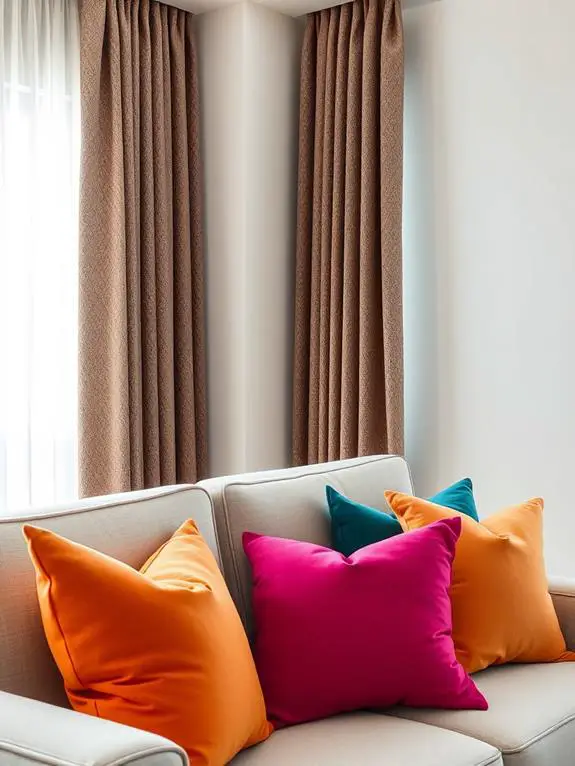
Understanding color theory can elevate your textile choices from simple to stunning. When selecting fabrics for your home, consider the emotions and atmosphere you want to create. Warm colors like reds, oranges, and yellows can bring energy and coziness to a space, while cool blues and greens promote calm and relaxation. Don't be afraid to mix and match! Complementary colors, found opposite each other on the color wheel, create vibrant contrasts that catch the eye. For a harmonious look, try using analogous colors – those that sit next to each other on the wheel. As the seasons change, consider incorporating fall-inspired textiles to transform your patio or indoor living spaces. Remember, neutrals like beige, gray, and white can serve as excellent bases, allowing you to experiment with pops of color through accent pieces. By thoughtfully applying color theory to your textile choices, you'll create a cohesive and inviting atmosphere that reflects your personal style.
Mixing Textures for Visual Interest
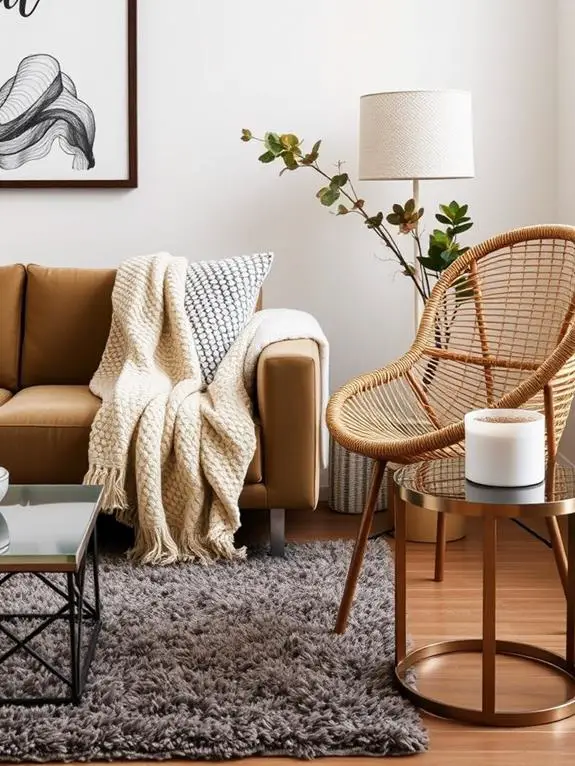
Alongside color theory, mixing textures is key to creating visually appealing textile combinations. You'll want to blend different fabric feels to add depth and interest to your space. Start by pairing smooth surfaces with rougher ones, like silky pillows against a nubby wool throw. For a cozy winter vibe, incorporate plush textures and warm fabrics that invite relaxation in your home office. Don't be afraid to mix and match: combine velvet cushions with linen curtains or a shaggy rug with sleek leather furniture.
DIY Textile Projects for Beginners
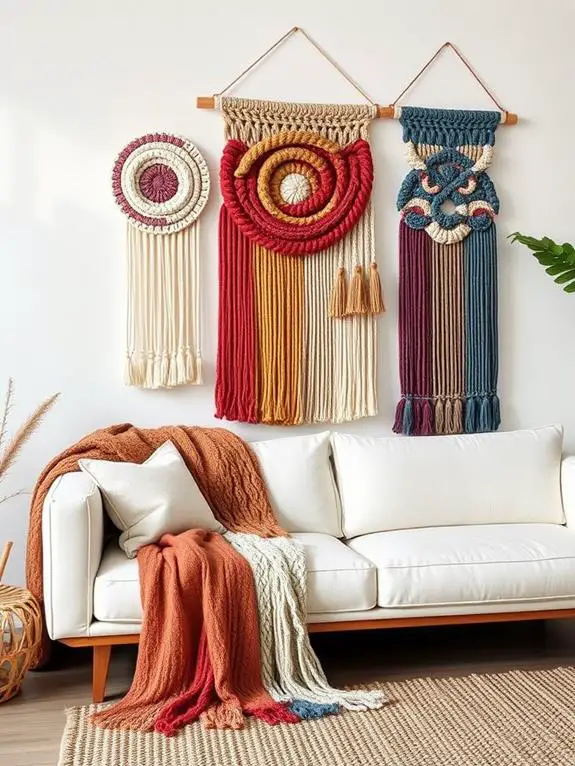
DIY textile projects offer a fantastic way to personalize your space without breaking the bank. You'll love how these simple crafts can transform your home with a cozy, handmade touch. Start with easy projects like no-sew pillowcases or fabric-wrapped canvas art. These beginner-friendly ideas will boost your confidence and spark your creativity. While some site features are unavailable during maintenance, you can still gather inspiration and plan your projects offline.
Try your hand at tie-dyeing old sheets or towels for a fresh, colorful look. Or, create a unique wall hanging by weaving strips of fabric on a makeshift loom. Don't be afraid to experiment with different textures and patterns. You might surprise yourself with hidden talents!
Repurposing Fabrics for Unique Decor
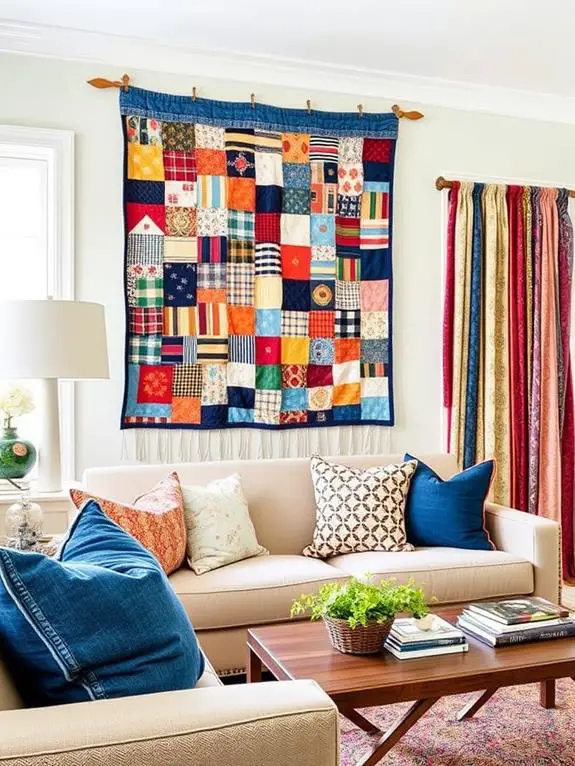
Repurposing fabrics is a clever way to breathe new life into your home decor while being eco-friendly and budget-conscious. You'll be amazed at how old textiles can transform your space with a little creativity. Those faded curtains you've been meaning to replace? Turn them into cozy throw pillows that add a splash of color to your sofa. That vintage tablecloth gathering dust in your linen closet? It could become a charming wall hanging or a unique lampshade. Don't overlook the potential of worn-out jeans or sweaters, either. They can be sewn into eye-catching patchwork quilts or fashioned into rustic rag rugs. For a seasonal touch, consider incorporating fall-inspired textiles into your hallway decor, creating a warm and inviting entrance to your home. By repurposing fabrics, you're not just saving money; you're creating one-of-a-kind pieces that tell a story and infuse your home with warmth and personality.
Sustainable Textile Options
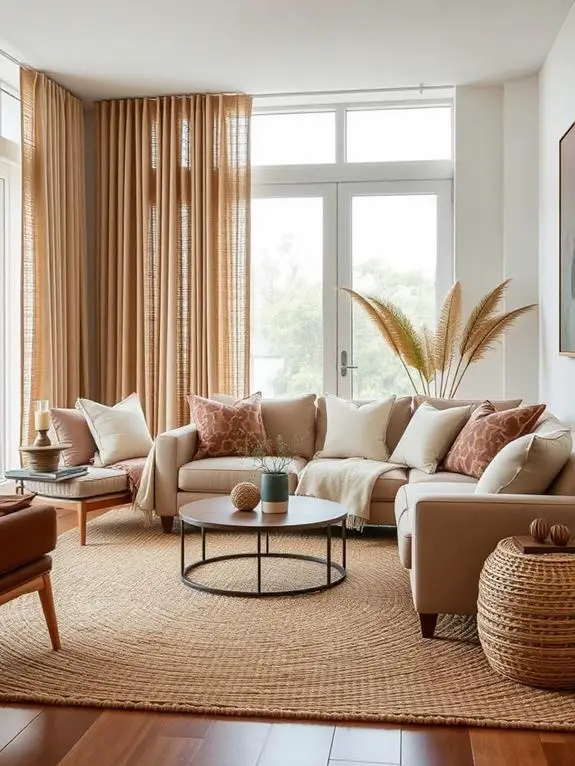
Sustainability in textiles is becoming increasingly important as consumers seek eco-friendly alternatives for their homes. You'll find a wealth of options that not only look great but also help protect our planet. Consider organic cotton, which feels soft against your skin and is grown without harmful pesticides. Bamboo fabric offers a luxurious, silky texture while being incredibly renewable. For a rustic touch, try hemp textiles, known for their durability and earthy appeal. Recycled polyester, made from plastic bottles, gives new life to waste materials while providing a cozy feel. Don't forget about Tencel, a fabric derived from wood pulp that's both breathable and biodegradable. These sustainable options can be used to create a spring garden atmosphere indoors, bringing nature's beauty into your living space. By choosing these sustainable options, you're wrapping your home in comfort while making a positive impact on the environment. It's a win-win for both style and conscience.
Textile Layering Techniques
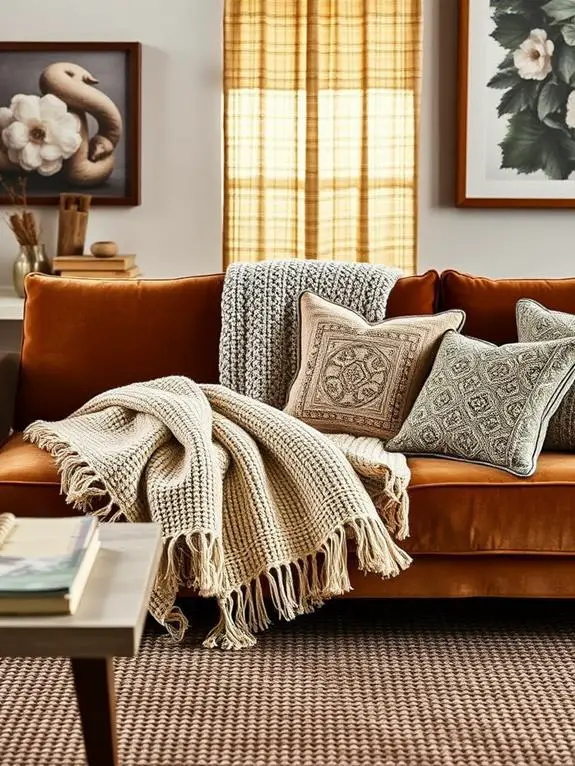
Layering textiles is a powerful technique to add depth, texture, and visual interest to any space. You'll love how it transforms your room into a cozy haven that's uniquely yours. Start with a base layer, like a plush area rug or soft throws, then build upon it with complementary fabrics and patterns. Don't be afraid to mix and match textures – it's all about creating a rich, inviting atmosphere.
Here are some layering ideas to inspire you:
- Drape a chunky knit blanket over a smooth leather sofa
- Stack pillows of varying sizes and fabrics on your bed
- Layer sheer curtains behind heavier drapes for a dreamy look
Maintenance of Budget Textiles
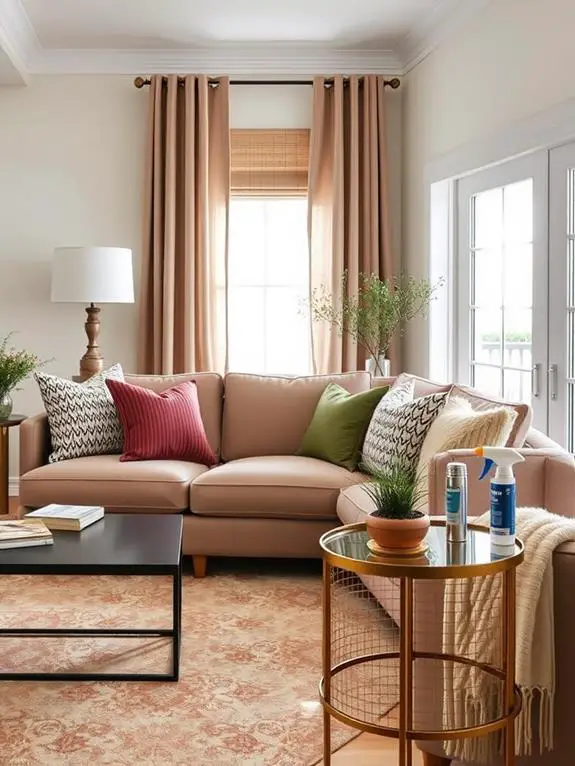
Caring for budget-friendly textiles doesn't have to be an intimidating task. With a little know-how, you can keep your affordable fabrics looking fresh and inviting for years to come. Start by reading care labels carefully and following their instructions. For most items, gentle washing in cool water and air-drying will do the trick. Treat stains promptly with a mild detergent, blotting rather than rubbing to preserve the fabric's integrity. To maintain the cozy feel of your textiles, fluff pillows regularly and rotate cushions to guarantee even wear. Don't forget to vacuum upholstery weekly to remove dust and debris. For delicate pieces, consider using protective covers or strategically placing throws to minimize direct contact. With these simple steps, you'll create a warm, welcoming space that looks great without breaking the bank.
Frequently Asked Questions
How Can I Incorporate Vintage Textiles Into a Modern Interior Design?
You don't need a time machine to bring vintage charm into your modern space! Start by mixing in a few key textile pieces like throw pillows or curtains with retro patterns. Layer different textures, such as a plush velvet armchair or a chunky knit blanket, to add depth. Don't shy away from bold colors or unique prints – they'll create eye-catching focal points. Remember, it's all about balance. Pair vintage textiles with sleek, contemporary furniture for a harmonious blend of old and new.
What Are the Best Textiles for Pet-Friendly Homes?
When it comes to pet-friendly homes, you'll want to choose textiles that can stand up to fur, claws, and occasional accidents. Opt for durable, easy-to-clean fabrics like microfiber, leather, or indoor/outdoor materials. These options resist stains and odors while remaining comfortable. Washable slipcovers are a great choice for sofas and chairs. For rugs, consider low-pile or flatweave styles that won't trap pet hair. Remember, darker colors or patterns can help hide any pet-related wear and tear.
How Do I Choose Textiles That Improve Indoor Air Quality?
Breathe life into your home with air-purifying textiles! You'll feel like you're walking through a fresh mountain breeze. Choose natural fibers like cotton, wool, and linen, which don't off-gas harmful chemicals. Look for fabrics treated with antimicrobial finishes to reduce allergens. Don't forget about indoor plants – they're nature's air filters! Opt for low-pile carpets or washable rugs to trap less dust. Remember, lighter colors show less dust, so you'll clean more often, keeping your air cleaner too.
Are There Textiles That Can Help With Soundproofing in Open-Plan Spaces?
Yes, there are textiles that can help with soundproofing in open-plan spaces! You'll love how they can transform your room. Consider thick, plush curtains or drapes that absorb sound waves. Fabric-covered acoustic panels are another great option – they're stylish and effective. Don't forget about rugs and carpets; they'll muffle footsteps and reduce echo. Upholstered furniture, like cozy sofas and chairs, also helps dampen noise. With these textile choices, you'll create a quieter, more peaceful environment in your open space.
What Are the Most Flame-Resistant Textiles for Home Use?
You'll find several flame-resistant textiles that can make your home safer. Wool is naturally fire-resistant and a cozy choice for blankets and rugs. For curtains and upholstery, look for fabrics treated with flame retardants like modacrylic or fiberglass. Kevlar, though pricier, offers excellent protection. Don't forget about leather – it's not only stylish but also resistant to flames. Remember, while these textiles help, they're not completely fireproof, so always prioritize fire safety in your home.
